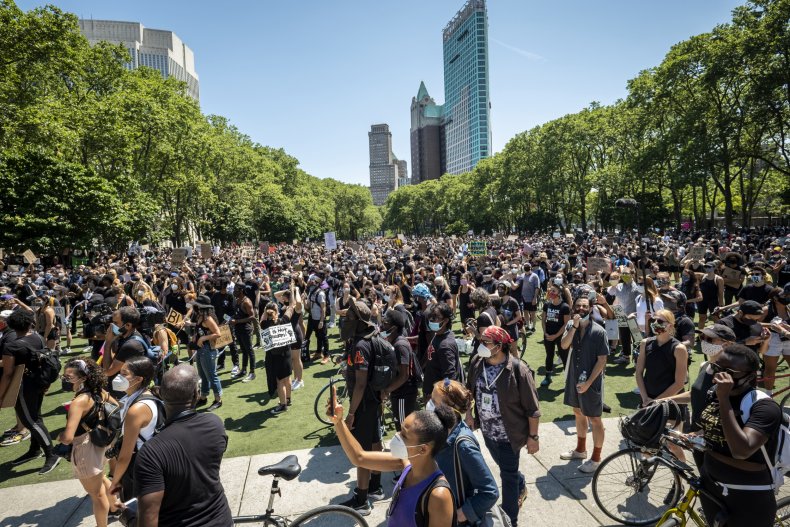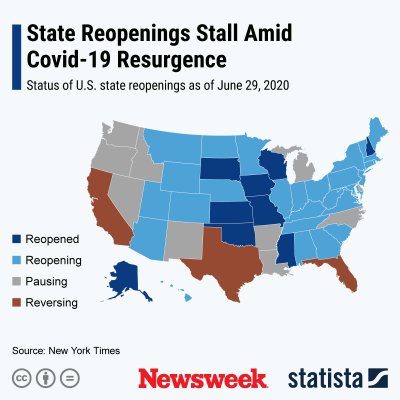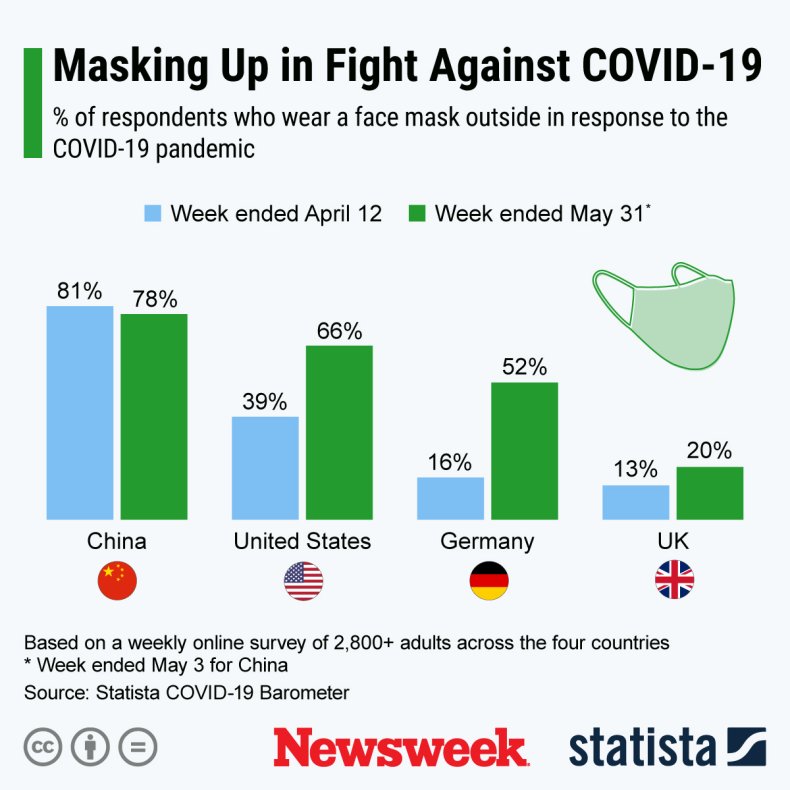AMERIKAN PLAGUE #CORONAVIRUSA #COVIDTRUMP
BY SOO KIM ON 7/3/20
New cases of the novel coronavirus in the U.S. climbed past 50,000 for the second consecutive day on Thursday. The latest daily figures surpassed the total confirmed cases seen in Wuhan, the Chinese capital of the Hubei province where the virus was first reported earlier this year.
The U.S. reported a record number of around 52,300 new infections Thursday, the highest daily case count since the outbreak began. Around 51,200 new cases were recorded Wednesday, according to data compiled by Johns Hopkins University.
Around mid-April, by which time the outbreak was reported to have been largely contained in China and restrictions were lifted in Wuhan after a two-month lockdown, Wuhan's health authorities reported total confirmed cases in the city were 50,333, China's state media Xinhua news agency.
Following a review of the city's epidemiological data, the Wuhan municipal headquarters for COVID-19 epidemic prevention and control issued a notification stating, as of April 16, confirmed infections in Wuhan were at 50,333, following an update of 325 additional cases. The death toll was also raised by nearly 50 percent, with 1,290 more fatalities, bringing the city's total fatalities to 3,869.
READ MORE
Chinese Citizens Use Fake Negative Coronavirus Tests to Leave Russia
Coronavirus Worldwide Death Toll Reaches 500,000
Italian Strain of Coronavirus Is Now More Dominant Than Original Wuhan One
Flu Virus With Pandemic 'Hallmarks' Emerges in China: Should We Be Worried?
"Previously, Wuhan reported a total of 50,008 confirmed cases of COVID-19 by the end of April 16. A total of 217 repeatedly counted cases should be deducted from the previous figure due to the fact that there were patients who saw doctors in different districts or visited more than one hospital," an official of the Wuhan municipal headquarters confirmed, Xinhua reported in April.
"Meanwhile, a total of 542 cases that were previously not tallied due to belated or missed reporting should be added to the figure. The accumulative number of confirmed cases was revised to 50,333," the official said.
Doubts over the COVID-19 data officially reported by China have swirled for months since the outbreak began. Back in April, 900 cases appeared to have been wrongly counted as recoveries in Wuhan, according to the latest figures from China's National Health Commission.
In February, China's health commission also reportedly removed 108 casualties from the death toll in Hubei after it emerged that some deaths were counted twice, Agence-France-Presse reported.
READ MORE
U.S. Coronavirus Transmission Rate: These States Have the Highest R Number
U.S. Coronavirus Cases Hit One-Day Record Sweeping Across 3 Largest States
U.S. Coronavirus Death Projection Falls by 20,000 Despite High Case Numbers
The notification issued in April by Wuhan health officials cited several reasons for the recent "data discrepancies," including delayed, missed or mistaken reporting due to hospital staff being overwhelmed by the surge in patients at the height of the outbreak, Xinhua reported in April.
The latest daily case counts in the U.S. approached nearly the same number as the total infections seen across the Hubei province, which has seen 68,135 cases to date, according to Johns Hopkins University.
The U.S. daily case totals for Wednesday and Thursday were each over three times the highest ever daily case count seen in China, which saw a record 15,100 new cases on February 13. The number of daily new cases in the U.S. began surpassing China's record daily case count from March 26 and continued to do so throughout the outbreak since, according to data compiled by Johns Hopkins University.
Daily new cases in the U.S. have been on a mostly increasing trend from early June, with several states, including Florida, Texas and California, seeing large spikes in recent weeks.
Last month, Beijing reported its first new domestic case in nearly two months after a 52-year-old man tested positive for COVID-19.

BY SOO KIM ON 7/3/20
New cases of the novel coronavirus in the U.S. climbed past 50,000 for the second consecutive day on Thursday. The latest daily figures surpassed the total confirmed cases seen in Wuhan, the Chinese capital of the Hubei province where the virus was first reported earlier this year.
The U.S. reported a record number of around 52,300 new infections Thursday, the highest daily case count since the outbreak began. Around 51,200 new cases were recorded Wednesday, according to data compiled by Johns Hopkins University.
Around mid-April, by which time the outbreak was reported to have been largely contained in China and restrictions were lifted in Wuhan after a two-month lockdown, Wuhan's health authorities reported total confirmed cases in the city were 50,333, China's state media Xinhua news agency.
Following a review of the city's epidemiological data, the Wuhan municipal headquarters for COVID-19 epidemic prevention and control issued a notification stating, as of April 16, confirmed infections in Wuhan were at 50,333, following an update of 325 additional cases. The death toll was also raised by nearly 50 percent, with 1,290 more fatalities, bringing the city's total fatalities to 3,869.
READ MORE
Chinese Citizens Use Fake Negative Coronavirus Tests to Leave Russia
Coronavirus Worldwide Death Toll Reaches 500,000
Italian Strain of Coronavirus Is Now More Dominant Than Original Wuhan One
Flu Virus With Pandemic 'Hallmarks' Emerges in China: Should We Be Worried?
"Previously, Wuhan reported a total of 50,008 confirmed cases of COVID-19 by the end of April 16. A total of 217 repeatedly counted cases should be deducted from the previous figure due to the fact that there were patients who saw doctors in different districts or visited more than one hospital," an official of the Wuhan municipal headquarters confirmed, Xinhua reported in April.
"Meanwhile, a total of 542 cases that were previously not tallied due to belated or missed reporting should be added to the figure. The accumulative number of confirmed cases was revised to 50,333," the official said.
Doubts over the COVID-19 data officially reported by China have swirled for months since the outbreak began. Back in April, 900 cases appeared to have been wrongly counted as recoveries in Wuhan, according to the latest figures from China's National Health Commission.
In February, China's health commission also reportedly removed 108 casualties from the death toll in Hubei after it emerged that some deaths were counted twice, Agence-France-Presse reported.
READ MORE
U.S. Coronavirus Transmission Rate: These States Have the Highest R Number
U.S. Coronavirus Cases Hit One-Day Record Sweeping Across 3 Largest States
U.S. Coronavirus Death Projection Falls by 20,000 Despite High Case Numbers
The notification issued in April by Wuhan health officials cited several reasons for the recent "data discrepancies," including delayed, missed or mistaken reporting due to hospital staff being overwhelmed by the surge in patients at the height of the outbreak, Xinhua reported in April.
The latest daily case counts in the U.S. approached nearly the same number as the total infections seen across the Hubei province, which has seen 68,135 cases to date, according to Johns Hopkins University.
The U.S. daily case totals for Wednesday and Thursday were each over three times the highest ever daily case count seen in China, which saw a record 15,100 new cases on February 13. The number of daily new cases in the U.S. began surpassing China's record daily case count from March 26 and continued to do so throughout the outbreak since, according to data compiled by Johns Hopkins University.
Daily new cases in the U.S. have been on a mostly increasing trend from early June, with several states, including Florida, Texas and California, seeing large spikes in recent weeks.
Last month, Beijing reported its first new domestic case in nearly two months after a 52-year-old man tested positive for COVID-19.

Thousands of protesters wearing masks gathered in Cadman Plaza, Brooklyn for a peaceful protest in support of the Black Lives Matter movement on June 19, 2020.GETTY IMAGES
Fears of a second wave of the outbreak were raised last month following a new cluster of cases linked to Beijing's Xinfadi wholesale food market, a sprawling complex over 20 times larger than the seafood market in Wuhan where the first outbreak is suspected to have originated, Reuters reported.
The new cases saw the Xinfandi market closed, while 11 residential areas near the market were placed under a strict lockdown. Ten communities near the Yuquandong market, which reported cases linked to Xinfadi, were also placed under lockdown.
The novel coronavirus has infected over 10.8 million people across the globe, including 84,830 in China and more than 2.7 million in the U.S. Over 521,300 people have died, while more than 5.7 have reportedly recovered from infection, as of Friday, according to the latest figures from Johns Hopkins University.
The graphics below, provided by Statista, illustrate the spread of COVID-19 in the U.S.
1 of 2
 STATISTA
STATISTA
The graphic below, provided by Statista, illustrates the portion of people who wore a mask in April and May amid the ongoing pandemic.
 STATISTA
STATISTA
The graphic below, provided by Statista, illustrates the seven-day rolling average of new COVID-19 cases in the U.S. and European Union.
 A graph comparing newly confirmed COVID-19 cases in the U.S. and Europe.STATISTA
A graph comparing newly confirmed COVID-19 cases in the U.S. and Europe.STATISTA
Fears of a second wave of the outbreak were raised last month following a new cluster of cases linked to Beijing's Xinfadi wholesale food market, a sprawling complex over 20 times larger than the seafood market in Wuhan where the first outbreak is suspected to have originated, Reuters reported.
The new cases saw the Xinfandi market closed, while 11 residential areas near the market were placed under a strict lockdown. Ten communities near the Yuquandong market, which reported cases linked to Xinfadi, were also placed under lockdown.
The novel coronavirus has infected over 10.8 million people across the globe, including 84,830 in China and more than 2.7 million in the U.S. Over 521,300 people have died, while more than 5.7 have reportedly recovered from infection, as of Friday, according to the latest figures from Johns Hopkins University.
The graphics below, provided by Statista, illustrate the spread of COVID-19 in the U.S.
1 of 2
 STATISTA
STATISTAThe graphic below, provided by Statista, illustrates the portion of people who wore a mask in April and May amid the ongoing pandemic.
 STATISTA
STATISTAThe graphic below, provided by Statista, illustrates the seven-day rolling average of new COVID-19 cases in the U.S. and European Union.
 A graph comparing newly confirmed COVID-19 cases in the U.S. and Europe.STATISTA
A graph comparing newly confirmed COVID-19 cases in the U.S. and Europe.STATISTA














